“Product marketers are the people responsible for being able to deeply understand and therefore articulate what is different and better and remarkable about your offering.” – April Dunford, Founder of Ambient Strategy
Seven years might not seem like much, but in product marketing it’s a lifetime. Back in 2019, product marketers were often misunderstood and flying under the radar. Fast forward to today, and they’re playing a central, strategic role in many companies.
Of course, this change didn’t happen overnight. It’s taken years of advocacy, getting buy-in from leadership, and PMMs consistently showing their value in high-pressure environments.
Here’s what changed and where there’s still room to grow.
From tactical execution to strategic influence
In 2019, one of the main frustrations for product marketers was the lack of clarity about the role itself. PMMs were often confused with content marketers or reduced to launch coordinators.
According to our State of Product Marketing 2019 Report, the top three frustrations were:
- A lack of understanding around PMM responsibilities.
- Limited resources and excessive workload.
- A lack of influence within their companies.
By contrast, the 2025 report paints a more empowered picture. PMMs are no longer scrambling for visibility. A growing number now report directly into senior leadership, including CMOs and VPs of Product Marketing – a significant shift from 2019, when most fell under generic marketing functions.
The data backs this up:
- In 2019, PMMs gave themselves a 6.5/10 for influence on company goals.
- By 2025, nearly 70% of PMMs are being invited into leadership meetings.
“Product marketing continues to mature as a distinct and strategic function. This year’s data shows more PMMs reporting into dedicated product marketing leaders and executives, with fewer rolling up to mid-level, generalist roles like “Head of Marketing” or “Director of Marketing.” This shift reflects a positive trend: PMM orgs that layer in more expertise, greater investment in the overall function, and stronger executive alignment with product marketing’s value.” – Tom Crist, Principal at Fluvio
Clearer scope, bigger impact
Seven years ago, 32.5% of PMMs managed five or more products. This was often a bandwidth problem, not a sign of scope empowerment. In 2025, while many PMMs still wear multiple hats, you can see more specialization and strategy.
The core PMM responsibilities have remained consistent: positioning, messaging, and product launches. However, new responsibilities have gained traction. In 2025:
- Sales enablement is up significantly (78.7% of PMMs now cite it as a core duty, up from 66.9% in 2023).
- Onboarding customers has more than doubled since 2023 (from 18.5% to 37.5%).
- Website and customer-facing content now fall under 65% of PMM teams.
This evolution shows PMMs taking ownership across the customer journey, not just at launch, but throughout onboarding, enablement, and even post-sale growth.
From a focus on launch to revenue drivers
In 2019, PMMs were still largely perceived as go-to-market “launch machines.” The top KPIs back then reflected this view: generating new revenue (58.1%), increasing MQLs (44.8%), and retaining customers (42%).
While these KPIs remain relevant in 2025, there's a stronger emphasis on demonstrating business impact, not just activity. For example:
- Revenue generation KPIs increased from 50.9% in 2024 to 53.2% in 2025.
- Win rate and upsell/cross-sell metrics are climbing, replacing vanity metrics like content volume or web traffic.
This shift could be due to PMMs having to justify their value in cold, hard metrics after waves of layoffs in 2024. It’s also a sign of maturity: PMMs are now expected to influence revenue outcomes directly, not just support them.
Budgets remain a sore spot
Most PMMs reported having a budget in 2019, but how much wasn’t clear.
In 2025, the data is sharper, and the picture is mixed, with 33.2% of PMMs reporting having no dedicated budget at all and 30.7% seeing an increase from 2024, while 18% experienced cuts.
Even among those with budgets, many fall into the $0–$25k range, limiting potential investment in research, tools, or enablement.
Yet, there’s also a trend toward smarter spending. Budgets are increasingly used for customer research, conferences, and sales enablement.
Less marketing-only orgs
In 2019, 54% of PMMs said they worked in “product-first” organizations. In 2025, that number is 41% – however, this is still an increase from 2024, where only 31.2% of respondents identified as product-first. Meanwhile, “marketing-first” cultures have dropped to just 2.5%.
PMMs are increasingly embedded in roadmapping, user research, and customer feedback loops: functions that go far beyond messaging.
“A change over the past year is a noticeable swing toward the marketing side of the function, specifically, being more aggressive in supporting revenue growth. There’s been a shift in how PMMs are prioritized and resourced: less emphasis on purely product-focused responsibilities, and more attention on initiatives that directly enable sales, like competitive intelligence, buyer-facing content, and campaign strategy.
“As budgets tighten or get reallocated, companies are expecting PMMs to be growth drivers, not just storytellers. That means aligning closer with sales, sharpening messaging for conversion, and moving faster to meet market needs.” – Laura Kaminski, Head of Product Marketing at iTradeNetwork
Still understaffed, but smarter teams
Team sizes haven’t exploded. In 2025, 44.3% of PMM teams are still just one to two people, and only 11.5% have more than 10. But the seniority mix has shifted.
In 2019:
- Product Marketing Managers made up 36.9% of the cohort.
- Directors and VPs combined were under 30%.
In 2025:
- Senior PMMs (28.9%) and Directors (11.4%) make up a larger share.
- Even CMOs (1.5%) now identify with the function.
This tilt toward seniority reflects a stronger appreciation for PMM’s strategic impact. It also means more leadership-level involvement in the direction of the product, the messaging, and growth initiatives.
Career growth and skill building
In both 2019 and 2025, most PMMs wanted to move up the ladder. But in 2025, there's an increase in PMMs looking to pivot. 10.6% want to change employers and roles, suggesting they want more variety and challenge.
The skills helping PMMs stand out vary too. In 2019, they were creativity, collaboration, and strategic planning. In 2025, positioning, sales enablement, data interpretation, and cross-functional influence are dominant.
In short, the PMMs who succeed today aren’t just storytellers; they’re business strategists.
“The data clearly shows a strong appetite among product marketers to change roles or explore new opportunities within their current organizations. This isn’t surprising, given that for too long, many PMMs have believed that the only career path is upward within product marketing.
“The reality is, PMMs possess a versatile, industry-agnostic skill set that can open doors beyond the traditional PMM trajectory. I’ve seen peers successfully transition into roles in sales, product management, and corporate strategy.
“Personally, I’ve built my career by identifying the 20% of my role I love most and making that 100% of my next opportunity. I’d encourage other PMMs to do the same, reflect on the part of the role that energizes you, and let that guide your next move.” – Amit Alagh, Global Product Marketing Manager at Wolters Kluwer
What still needs work?
Despite the massive strides made over the last seven years, there are still real challenges:
- Prioritization remains a major issue. PMMs are stretched thin, pulled between product, sales, and executive stakeholders.
- Budgets are inconsistent. A third of PMMs still report having no dedicated funding.
- The role still lacks clarity in many orgs. Confusion about PMM vs. content marketing or demand gen still hampers effectiveness.
- Not every PMM has a seat at the table. Nearly 31% still aren’t invited to leadership meetings.
TL;DR
From 2019 to 2025, product marketing has clearly leveled up from “launch coordinator” to strategic growth partner. PMMs are increasingly included in roadmap decisions, own key revenue metrics, and are recognized as vital cross-functional leaders.
But influence isn’t universal. There are budget disparities, confusion with the role, and a lack of resources, all of which affect the ability of many PMMs to reach their full potential.


















 Follow us on LinkedIn
Follow us on LinkedIn



.svg?v=e54e337f71)